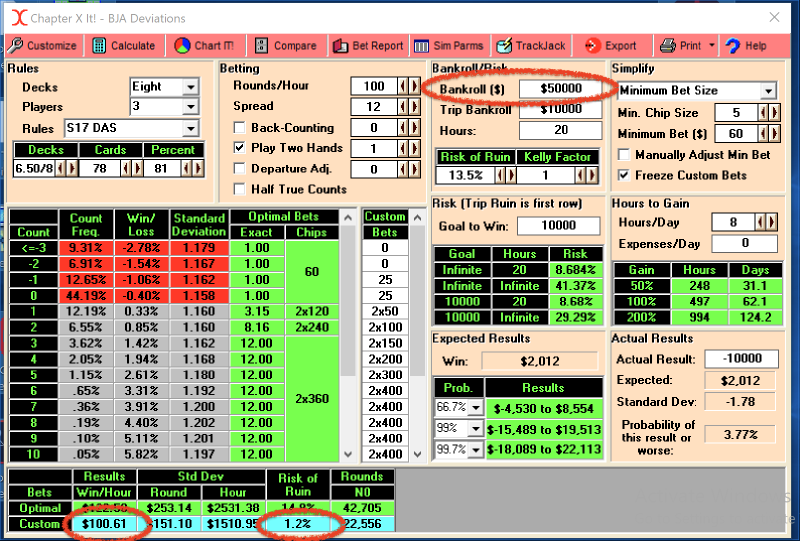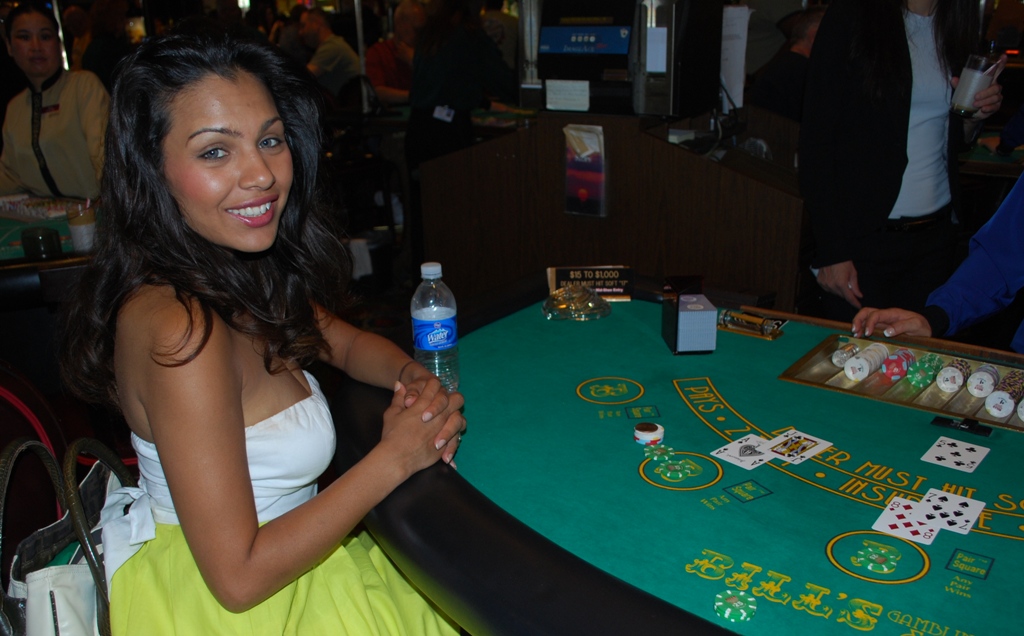Blackjack Bankroll Risk Of Ruin
- Bankroll Management Calculator Blackjack
- Blackjack Bankroll Risk Of Ruin The Following
- Blackjack Bankroll Risk Of Ruin Wisdom
- Blackjack Bankroll Risk Of Ruin Death
- Risk Of Ruin Blackjack Calculator
- Blackjack Bankroll Risk Of Ruin Breath
Top Blackjack Sites Online
The bankroll needed for a 5% risk of ruin is about 2.2 times the bankroll that your method would compute. If we want a 1% risk of ruin, the bankroll required is about 2 times what your method would compute. If we want a 0.13% risk of ruin, the bankroll required would be about 1.5 times what your method would compute. Blackjack Bankroll Calculator This screen can be used to calculate your bankroll needs given a desired risk of ruin. Here, risk of ruin is defined as the probability that you will go bankrupt within a specified number of hands. There are five variables defined as follows.
I was explaining the basics of card counting to a stats guy I know, and he pointed something that really stumped me. I don’t get what risk of ruin means, I don’t think. If you have any non-zero risk of ruin, and you play long enough, won’t you always eventually hit a streak bad enough to wipe you out? In which case, what does it mean to have a 5% risk vs. A 2% risk, if everyone busts. Obviously the lower the risk, the lower our returns. This chart displays our win rate given four possible risks of ruin: 13.5%, 5%, 2% and.025%. That is, we are setting bets such that our risk of losing our entire bankroll varies from 13.5% to 0.025%. All penetrations are displayed from 26 to 130 cards cut off. In other words, the amount of money you can risk divided by the amount of each bet. For example, if you had $5,000 and were to play video poker at $1.25 a bet, your bankroll would be $5,000/$1.25 = 4,000. Risk of ruin — Leave this blank. When you click calculate the program will provide an estimate of the probability of running out of money.
It’s wise to know the risks of losing set amounts of money when playing Blackjack games. The more you know about the risks you are taking at the table, the easier it is to control the amount you can potentially lose (or hopefully win) from one session to the next. This article will cover the basics of the “risk of ruin” in Blackjack to help you understand how you can minimize, or increase, the risk involved the next time you sit down at the Blackjack table.
What is risk of ruin?
Risk of ruin is the percentage likelihood of losing a set amount of money over a specific number of hands at the Blackjack table. Ruin is just a way of saying “going broke”. For example, if you decided to take a $100 bankroll and bet $1 on each hand for 100 hands, your risk of ruin would be 0.5% (or a 1 in 200 chance of going broke).
I’ll show you how I worked this out in a moment.
Why learn about the risk of ruin?
Risk of ruin is perfect if:
- You want to stay in control of risk as much as possible.
- You want to know the varying risk for different bet sizes and number of hands.
- You want to clear bonus play-through requirements as quickly but as safely as possible.
Almost every gambler takes risk of ruin in to account when they place their bets, providing that they are sober of course. This article is simply going to help you put some numbers to that intuition.
The Blackjack risk of ruin table.
- The risk of ruin column is on the left.
- The number of hands row goes along the top.
- The centre numbers show the number of betting units. (Don’t worry; I’ll explain all of this very soon.)
Risk of Ruin Blackjack Charts
| Risk of Ruin | Number of Hands to Play | ||||||||
| 100 | 200 | 300 | 400 | 500 | 600 | 700 | 800 | 900 | |
| 50% | 7 | 11 | 14 | 16 | 18 | 20 | 22 | 24 | 25 |
| 40% | 9 | 14 | 17 | 20 | 23 | 25 | 27 | 29 | 31 |
| 30% | 12 | 17 | 21 | 25 | 28 | 31 | 33 | 36 | 38 |
| 20% | 15 | 21 | 26 | 31 | 34 | 38 | 41 | 44 | 47 |
| 10% | 19 | 27 | 34 | 39 | 44 | 48 | 53 | 57 | 60 |
| 5% | 22 | 32 | 40 | 46 | 52 | 58 | 62 | 67 | 71 |
| 4% | 23 | 34 | 42 | 49 | 55 | 60 | 65 | 70 | 75 |
| 3% | 25 | 36 | 44 | 51 | 58 | 64 | 69 | 74 | 79 |
| 2% | 27 | 38 | 47 | 55 | 62 | 68 | 74 | 79 | 84 |
| 1% | 29 | 42 | 52 | 61 | 68 | 75 | 82 | 88 | 93 |
| 0.5% | 32 | 46 | 57 | 66 | 74 | 82 | 89 | 95 | 101 |
| 0.25% | 35 | 50 | 61 | 71 | 80 | 88 | 96 | 102 | 109 |
| 0.1% | 38 | 54 | 67 | 77 | 87 | 95 | 104 | 111 | 118 |
| 0.01% | 45 | 64 | 79 | 91 | 102 | 112 | 122 | 131 | 139 |
| Risk of Ruin | Number of Hands to Play | ||||||||
| 1000 | 1200 | 1400 | 1600 | 1800 | 2000 | 2500 | 3000 | ||
| 50% | 27 | 30 | 32 | 35 | 37 | 40 | 45 | 50 | |
| 40% | 33 | 37 | 40 | 43 | 46 | 49 | 56 | 62 | |
| 30% | 41 | 45 | 49 | 53 | 56 | 60 | 68 | 75 | |
| 20% | 50 | 55 | 60 | 65 | 69 | 73 | 83 | 92 | |
| 10% | 64 | 70 | 76 | 82 | 88 | 93 | 105 | 116 | |
| 5% | 76 | 83 | 90 | 97 | 104 | 110 | 124 | 137 | |
| 4% | 79 | 87 | 95 | 102 | 108 | 114 | 129 | 143 | |
| 3% | 83 | 92 | 100 | 107 | 114 | 121 | 136 | 151 | |
| 2% | 89 | 98 | 107 | 114 | 122 | 129 | 145 | 161 | |
| 1% | 99 | 108 | 118 | 126 | 134 | 142 | 160 | 177 | |
| 0.5% | 107 | 118 | 128 | 137 | 146 | 154 | 174 | 192 | |
| 0.25% | 115 | 126 | 137 | 147 | 156 | 166 | 187 | 206 | |
| 0.1% | 125 | 138 | 149 | 160 | 170 | 180 | 202 | 223 | |
| 0.01% | 148 | 162 | 175 | 188 | 198 | 212 | 236 | 261 | |
Bankroll Management Calculator Blackjack
Both risk of ruin tables were originally published on the Wizard of Odds blackjack risk of ruin article.
The 3 variables involved with risk of ruin in Blackjack.
Whenever you work out risk of ruin in Blackjack, there are 3 variables you need to consider.
1. The number of betting units (this is just your bankroll divided by bet size).
2. The set number of hands to be played.
3. The risk of ruin.
As long as you know at least 2, any 1 of the 3 remaining variables can be worked out using the table above.
Example 1: Working out your risk of ruin.
Let’s say that you have a $200 bankroll and you want to play 300 hands whilst betting $5 on each hand. You now decide that you want to work out your risk of ruin for this session.
By betting $5 on each hand with our $200 bankroll, we have 40 betting units in total ($200 / $5). Now we have 2 our variables, we can figure out our risk of ruin from the table.
Firstly we look across the top row to find the number of hands we wish to play (300, remember?). We then look down this column to find the betting units closest to 40. Luckily 40 is perfectly set in the table there already, so we can look across to the left to the risk of ruin column and see that our risk of ruin for this session will be 5%.
Easy stuff really. All you need to know is 2 variables/numbers from the table and you can work out your risk of ruin, the number of hands you should play or the number of betting units required.
Example 2: Working out your ideal betting units.
A more probable situation is where you want to control your risk of ruin before you play. So for example, let’s say you have a $1000 bankroll and you want your risk of ruin to be 1% over 500 hands. How big should your bets be?
If we look at 500 hands and the 1% risk of ruin on the table, it tells us that we should have 68 betting units behind us to achieve these figures. So what’s 68 betting units from $1000?
Easy, just divide $1000 by 68 and we get $14 (or $14.7 to be precise). Therefore to play 500 hands with just a 1% risk of ruin, we should only bet $14 on each hand we play.
Blackjack Bankroll Risk Of Ruin The Following
Evaluation of risk of ruin in Blackjack.
Risk of ruin applies to all forms of gambling, whether it’s; Sports Betting, Texas Hold’em Poker, Bingo or Casino games like Blackjack (of course).
Even though we all subconsciously work out rough ideas of the risk of ruin in our heads, it’s far better to have solid numbers to work with so that we can be more precise with the money we are putting at risk. The last thing any of us want is to be surprised by losses that we never could have expected.

Blackjack Bankroll Risk Of Ruin Wisdom
I realise that I’ve left out an example for working out how many hands you should play if you have a risk of ruin in mind and have already worked out your ideal betting units, but it should be fairly easy to figure out if you understood the first two examples.

The mathematics involved with risk of ruin may look a little intimidating at first, but trust me when I say that it’s so much easier than it looks if you spend a little time working with it.
Main Menu
Blackjack Games
Blackjack Bankroll Risk Of Ruin Death
Card Counting
Risk Of Ruin Blackjack Calculator
By John Grochowski
My friend Mark isn’t a casino regular, but he likes to play a little video poker now and then. His goal is just to have a good time and stay in action for a couple of hours.
“Do you have a guide to how much cash I need to last a couple of hours?” he asked.
I showed him the bankroll calculator on Video Poker for Winners software, and assumed expert play for 1,000 hands --- about two hours play for anaverage player.
First up was Jacks or Better on three pay tables --- the full-pay 9-6 game, paying 9-for-1 on full houses and 6-for-1 on flushes, which returns 99.54 percent with expert play; the 8-5 game(97.30 percent); and the 7-5 game (96.15 percent) that’s becoming all too common on quarter games.
Jacks or Better is the least volatile of common video poker games, a game that’s designed to keep you in your seat. There are no big four-of-a-kind bonuses that are going to make your day. Allquads pay 125 coins for a five-coin wager. But the 2-for-1 payoff on two pairs packs a different kind of wallop, one that will keep you going for extra chances at the bigger pays.
The average loss for two hours of betting $1.25 a hand on a quarter machine is $5.75 with a 9-6 pay table, $34.75 at 8-5 and $48.12 at 7-5 --- which ought to tell you why I’m alwaysharping on finding the best pay tables. In the days when each video poker machine had just one game --- no touching the screen to try a different game --- I once found a long row of 18 machinesthat alternated between 9-6 and 8-5 pay tables. There were as many players at the low-payers as at the 9-6ers. Ugh.
The required bankroll is much higher than the average loss if you want to give yourself enough for a 5 percent risk of ruin --- a 95 percent chance of surviving two hours without losing it all.That takes $165 on 9-6 Jacks, $185 at 8-5 and $195 at 7-5.
Your chances of having a winning session after two hours are 34.54 percent at 9-6, 22.35 percent at 8-5 and 17.19 percent at 7-5. Settling for a 7-5 pay table instead of 9-6 cuts your chancesof winning in half.
Then I checked probably the most popular video poker game: Double Double Bonus Poker. With a 9-6 pay table, it’s a 98.98 percent return, $12.75 average loss in two hours on a quarter machine,with a $300 bankroll for a 5 percent risk of ruin and a 35.46 percent chance of a winning session. On the 8-5 version that’s become all too common, the payback percentage falls to 96.79percent, average two-hour loss increases to $40.12, the bankroll requirement rises to $320, and the chance of a winning session drops to 30.75 percent.
Double Double Bonus Poker is the more volatile game, with more of its payback concentrated into relatively rare four-of-a-kind hands. Most quads pay 250 for a five-coin wager, and the rewardrises to 400 on four 2s, 3s or 4s; 800 if those low quads are accompanied by an Ace, 2, 3 or 4 kicker; 800 on four Aces; and 2,000 on four Aces with a 2, 3 or 4 kicker. The two-pairs return isreduced to 1-for-1 ---- you just get your money back.
That’s why Double Double Bonus bankroll requirements are higher than in Jacks or Better. But in any game, cuts in the pay table slash your chances of winning. Be wary.
LONGER SESSIONS: Two-hour sessions are extremely volatile. Just about anything can happen in any session as short as a couple of hours. But I’ve had many a two-hour session back when that wasthe length of a riverboat casino cruise, and still often go to a local casino to play for a couple of hours and have lunch or dinner.
But what if you’re going to play longer? What if you’re going on an overnight stay and figure to get in, say, 10 hours of play? Do you have to multiply two-hour bankroll requirements byfive?
No, you don’t. Longer sessions smooth things out a bit. For 10 hours of quarter play on 9-6 Jacks or Better, the bankroll for a 5 percent risk of ruin doesn’t quintuple from $165 to $825.Instead, it’s less than tripled, at $450, while the bankroll requirement for 8-5 Jacks rises to $570.
On the more volatile Double Double Bonus Poker, that $300 bankroll for a 5 percent risk or ruin for two hours rises to $885. That’s a big chunk of cash, but at least it’s not the $1,500 you getwhen multiplying the $300 by five. On the 8-5 version, the bankroll needed for 10 hours is $1,010, and that’s one reason I just won’t play 8-5 Double Double Bonus Poker.

Blackjack Bankroll Risk Of Ruin Breath
John Grochowski writes about casino games and the gambling industry in his weekly 'Gaming' column, which is syndicated in newspapers and Web sites across the United States. John is also theauthor of six books on casinos and casino games.